
Oral Cancer Screening in New York City
Serving Midtown East, Upper East Side & Surrounding Areas
Every hour, someone in the United States dies from oral cancer. Recently, the American Cancer Society published statistics that show deaths from other types of cancer are on a steady decline, while fatal cases of oral cancer have recently been increasing. This may be due to a lack of awareness of the causes, signs, and symptoms of oral cancer, combined with infrequent screenings. Oral cancer is a curable disease when discovered in its early stages, and Dr. Lazare’s dental practice offers patients ViziLite Plus® as part of a yearly oral cancer screening examination.
Contact us at (332) 334-8290 to book your annual oral cancer screening appointment.
Risk Factors for Mouth Cancer

About 25% of those diagnosed with oral cancer have no risk factors that lead to its development, while 75% of oral cancers are attributed to tobacco use and drinking alcohol.
Types of tobacco that put people at risk include:
- Cigarettes
- Cigars
- Pipes
- Chews
- Snuff
Some types of oral cancer, especially lip cancer, might be linked to unprotected sun exposure.
HPV Oral Cancer
Oral HPV or human papillomavirus can cause the development of cancerous lesions on the tongue, tonsils, or back of the throat (oropharynx). An oral cancer dentist or doctor may be able to make the diagnosis, depending on which area of the mouth is affected.
Oral cancer rates have historically been higher in men, African Americans, and older individuals. While cancer can be caused by several genetic factors beyond a person’s control, behavior, specifically smoking, is the underlying cause for most cases. About 90% of those with oral cancer developed the disease due to tobacco use.
How to Prevent Oral Cancer
Preventative measures can be taken to lower your risk for oral cancer. Such measures include reducing or stopping the use of tobacco and the consumption of alcohol, using an SPF lip balm, improving one’s diet and lifestyle, and undergoing annual oral cancer testing.
Oral Cancer Screening
Early detection of mouth cancer is possible through annual oral cancer testing.
Using a special technique that includes the palpation of tissue, along with a bright light for visual examination, Dr. Lazare will evaluate the lips, face, head, and neck. He will check all soft tissues inside the mouth, including the inside of the lips, gums, cheeks, base of the tongue, and below the tongue for any irregularities and signs of mouth cancer.
In addition to the visual and physical inspection, Dr. Lazare might also use fluorescent light, dyes, oral rinses, or the ViziLite Plus® test, for one of the most comprehensive oral cancer screenings available in New York City. Findings that may indicate the presence of mouth cancers include lesions or tissue discoloration.
The ViziLite Plus® Screening Test
In addition to the assessment of the oral cavity, Dr. Lazare has adopted the use of ViziLite Plus® into his Manhattan dental practice for oral cancer testing. First, patients will swish a solution in their mouth to coat the areas to be further inspected.
Next, the lights in the exam room will be dimmed so Dr. Lazare can use a special light to view the tissues of the mouth. Abnormal cells will appear to glow under the light and can be scraped off and collected for biopsy. ViziLite Plus® provides an enhanced method for how to diagnose throat cancer early.
Oral Cancer Signs & Symptoms

During the cancer screening process, patients often ask, “What do the early stages of mouth cancer look like?” The answer is: it depends. Oral cancer symptoms can vary widely depending on which area of the mouth is affected.
A sore on the lip might be a sign of lip cancer, while a lesion in the mouth or multiple mouth canker sores that do not heal despite intervention are a hallmark sign of the disease. Other visual changes can include red or white patches on the tongue, gums, or mucous membranes (lining) in the mouth, or even on the tonsils.
Why It's Important to Have Oral Cancer Symptoms Professionally Evaluated
Scheduling an appointment with Dr. Lazare to discuss your oral cancer symptoms is of paramount importance due to the critical nature of early detection. Annual oral cancer screenings are recommended as they can significantly increase the chances of identifying any potential issues in their initial stages. Symptoms of oral cancer can vary widely based on individual circumstances, making professional evaluation essential.
Dr. Lazare's expertise ensures a thorough assessment, allowing for timely intervention if any abnormalities are found. By catching oral cancer early, the treatment process can be more effective and less invasive, leading to better outcomes. Don't delay—book an appointment to discuss your symptoms with Dr. Lazare, safeguarding your oral health and overall well-being through proactive care.
Other Gum Cancer Symptoms
Some warning signs of mouth cancer may be ongoing pain or swelling in the mouth or throat, numbness in the mouth, loose teeth, and unexplained bad breath, which can indicate cancer of the oral cavity or other oral health issues.
More obvious signs are a cheek lesion or a lesion on the gums, often described as a “crater in the mouth,” or lumps present in the mouth or neck. Patients suspecting early signs of mouth cancer should seek diagnosis and treatment to prevent spread beyond stage 1 oral cancer, which is characterized by a tumor that is a maximum of 2 cm in diameter with no cancer cells present locally, in the lymph nodes, or other areas of the body. After oral cancer has spread, sufferers sometimes report weight loss.
Head and Neck Cancers: Oropharyngeal Cancer



 Often called throat cancer, cancer of the oropharynx can also be detected early. Patients who have been infected with HPV and smokers are typically more at risk than others. Symptoms of oral cancer in the back of the throat include a sore throat or a lump found in the neck. In some cases, a person affected by this type of cancer may notice a change in their voice.
Often called throat cancer, cancer of the oropharynx can also be detected early. Patients who have been infected with HPV and smokers are typically more at risk than others. Symptoms of oral cancer in the back of the throat include a sore throat or a lump found in the neck. In some cases, a person affected by this type of cancer may notice a change in their voice.
While signs of mouth cancer in other parts of the mouth are sometimes more visible in the form of a lesion, oropharyngeal cancer can sometimes be felt by the patient. An annual oral cancer screening may include a questionnaire to determine if any of the symptoms of oropharyngeal cancer exist.
Tests for Oral Cancer
The first line of defense against oral cancer is a total mouth cancer screening that occurs during annual appointments. If any changes in the mouth are noted that raise suspicions of oral cancer, Dr. Lazare can request a biopsy or refer the patient to their primary care doctor.
Blood work, an endoscopy, and imaging tests like PET scans can assist in the diagnosis of cancer of the oral cavity. When the first symptoms of oral cancer and premalignant lesions are diagnosed through oral cancer testing, treatment can begin right away. In general, these early-stage cancers require less extensive treatments and have much higher survival rates.
What Are Common Oral Cancer Signs?
The two types of lesions that could be the precursors to cancer are white lesions (called leukoplakia) and red lesions (called erythroplakia). The red lesions are less common, but they have a greater potential to become cancerous. If a red or white lesion does not resolve itself within two weeks, it should be reevaluated, and a biopsy should be considered for a definitive diagnosis.
Other possible signs and symptoms of oral cancer include:
- Difficulty in chewing or swallowing
- Numbness of the tongue
- Hoarseness
- Ear pain
- Difficulty when moving the tongue or jaw
- A lump or a thickening of the soft tissues in the mouth
If any of the above symptoms last for more than two weeks, a thorough exam and lab tests may be necessary.
What Can Be Done to Detect Oral Cancers?
With oral cancers, the earlier the detection, the greater the prognosis. Oral cancer is known to spread fairly quickly, with only half of those diagnosed surviving more than five years. Your dentist should incorporate or request your permission to perform an oral cancer screening exam each year as part of the office protocol. If they don’t offer the exam to you or perform this task, you should request the exam or seek care elsewhere.
The exam should include an overall evaluation of the face, lips, head, and neck, with a thorough inspection of the inside of the upper and lower lips, the gums, the inside of the cheeks, the floor of the mouth, the tongue (the sides, top, and underside), and the roof of the mouth. Newer types of oral cancer exams include tests that use fluorescent lights and special rinses and dyes (such as Toluidine Blue) to help dentists spot abnormal changes in the mucous membranes that line the inside of the mouth and throat.
Oral Cancer Treatment
Surgical excision of the affected tissues might be necessary during all phases of mouth cancer but depending on the stage and spread of the disease, additional treatments might be necessary. Radiation therapy and chemotherapy are commonly used in the treatment of all types of cancer, including oral cancer. In more advanced cases, immunotherapy can be provided in advanced stage oral cancer that persists despite traditional cancer treatments.
Non-Cancerous Lesions in the Mouth
It can be alarming to discover changes to the soft tissues in the mouth, but many common lesions and abnormalities can occur in the mouth that may not be related to cancer.
During an oral cancer screening test, Dr. Lazare may notice physical changes that are ultimately benign. These may include:
Aphthous Stomatitis (Canker Sore)
These common lesions occur in about 20% of people, more commonly in those who are experiencing stress. Certain irritants are thought to trigger canker sores. These painful bumps appear as small yellow or white lesions surrounded by a circular red area.
They may form on the lips, cheeks, gums, or even the sides and base of the tongue. An especially painful site is the floor of the mouth. Canker sores can occur as a single sore or multiple sores. They may last from a week-and-a-half to two weeks and can be treated with topical ointments.
Traumatic Oral Ulcers
After trauma to the upper tissue layers in the mouth, traumatic ulcers can form. Typically caused by dental work or injections, biting the tongue or cheek, or hard pieces of food, these ulcers often look like canker sores.
With an inner core that is white or yellow in color surrounded by a red border, the difference in traumatic ulcers is that rather than being an inverted sore, they can contain a pocket of pus. Topical numbing products can help ease the pain of these sores, and they should heal on their own.
Herpes Simplex Virus (HSV)
The two strains of HSV are Type I (HSV-1) which appears as cold sores or fever blisters on the face and lips and is spread through saliva, and Type II (HSV-2) which is sexually transmitted and causes local sores in the genital area.
In either type, there may be ulcers that are reddish in color and eventually scab over. The virus is incurable but is generally dormant and can appear during times of stress, both physical and psychological, that affect the immune system.
People may have enlarged lymph nodes or fever during a herpes outbreak. Avoiding physical contact with another person’s sores and antiviral medications, both oral and topical, can prevent their spread and help control an active infection.
Oral Lichen Planus Ulcers
Lichen planus is an inflammatory condition that can affect many areas of the body, including the mucous membranes. In the mouth, this tissue is known as the oral mucosa. The white marbled patches, small bumps, and ulcers occur in the mouth (lips, tongue, gums, cheeks, throat) but cannot be transmitted to others.
Lichen planus is characterized as a chronic autoimmune condition, but why it occurs is unknown. It is prevalent in many hepatitis C patients. Sometimes, flare-ups last weeks, but other cases may not resolve for months or years.
There is no cure for oral lichen planus, but the condition can be controlled through medications and homeopathic remedies.
Acute Necrotizing Ulcerative Gingivitis (ANUG or “Trench Mouth”)
A common disorder in soldiers during World War I, ANUG can occur with stress, smoking, bad oral hygiene, and poor nutrition. Those who are immunocompromised may also be at risk for this oral infection.
ANUG appears as ulcers in the mouth, swollen tissue, and tissue sloughing in mouth, including gum sloughing. Sufferers of trench mouth also can have bad breath. When affected by ANUG, people may have a fever, swollen lymph nodes, and may feel fatigued. The disorder can be treated with an antibacterial rinse, nutritional supplements or a change in diet, and rest.
It should be noted that some foods and toothpaste may cause a minor sloughing of the cheeks or gums, and this is often harmless.
Linea Alba Buccalis or White Line Inside Lower Lip
The white scar that occurs on the inside of the cheeks due to repeated biting can also be seen inside the lower lip for the same reason.
Sometimes confused for a malignant sore, oral leukoplakia or any oral cavity lesion that is white in color are not precancerous lesions. Patients may have an issue with their bite patterns, teeth grinding, or bite their cheeks and lips as a nervous habit.
Do you recognize any oral cancer signs? Contact the office at (332) 334-8290 for an oral cancer screening near you.

Frequent Oral Cancer Screening Questions
-
How Does Dr. Lazare Conduct an Oral Cancer Testing?Each year, Dr. Lazare will conduct an oral cancer screening test of a patient’s head, neck and oral cavity – the face, lips (outer and inner), cheeks, gums, tongue, the roof of the mouth, and the floor of the mouth.
He uses methods that include visual inspection, using a special dye and light to detect irregular cell growth, palpating or physically assessing these areas, and will ask pertinent questions. Dr. Lazare also takes the time to educate his patients and can inform them of what to look for while brushing and flossing. -
What Types of Cancers Are Found in the Mouth and Oropharynx?The majority of oral cancers – over 90% – are squamous cell carcinomas that begin in the lining of the mouth and throat. The cancerous cells begin in the epithelium, or uppermost layer of tissue and grow deeper over time. Cancerous tissue can be discovered at an earlier stage.
Fewer than 5% of oral cancer cases are caused by verrucous carcinoma. This type of cancer grows slowly and deeper into local tissue, but rarely spreads to different areas of the body. When left untreated, squamous cell cancer can grow inside verrucous carcinomas which can spread in the body. Lesions of verrucous carcinoma require more significant removal with large borders to help prevent this from occurring.
Oral cancers can also include different types of minor salivary gland carcinomas, lymphomas that occur in lymphoid tissue, and cancer of the nasopharynx and the larynx. -
Where Can Oral Cancer Occur?Oral or mouth cancer can affect the following parts of the mouth:
• Outer and inner lips
• Hard and soft palate (roof of the mouth)
• Cheeks
• Gums
• Tongue
• The floor of the mouth
Oropharynx Oral cancer is a type of head and neck cancer. -
What Is the Typical Oral Cancer Survival Rate?Per the American Cancer Society, when diagnosed early with oral cancer, the 5-year survival rate is approximately 84%, while the 5-year survival rate overall for those with mouth or throat cancer is 65%. Those who developed cancer as a result of HPV have higher survival rates.
Cancer patients with disease that has spread to surrounding tissue have a 5-year survival of 65%, while those with distant spread have a 5-year survival rate of 39%. -
How Is Gum Cancer Diagnosed?The patient or dentist may notice a sore, lumps, or thickened areas of the gums in oral cancer that is present in the gums. Discoloration of the area can include red and white patches, and the lesion or area may bleed.
Gum cancer can be identified by oral cancer testing performed in NYC at Dr. Lazare’s dental office and can be confirmed through additional medical tests. -
What Are Common Tongue Cancer Symptoms?Patients may notice one or more sores on the tongue that persist over a period of weeks. Other visible signs are patches of red or white tissue on the tongue that do not go away over time. Tongue cancer can also cause pain or conversely, numbness of the tongue or other parts of the mouth.
-
I couldn't be happier with Dr. Marc Lazare's caring and skilled dental work, or with his friendly and efficient staff.
- Cynthia
to Get Started? Call Us at 332-334-8290 or Schedule Your Next Visit
-
Monday: 8am - 5pm
-
Tuesday: 8am - 5pm
-
Wednesday: 10am - 7pm
-
Thursday: 8am - 5pm
-
Friday: 8am - 5pm
-
Saturday: 9am - 6pm
-
Sunday: Closed

